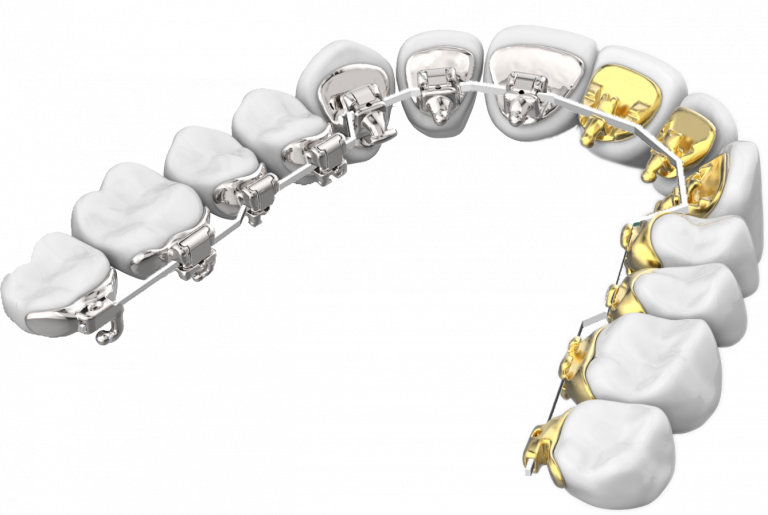400-300 BCE
Braces have been around for nearly as long as crooked teeth and date as far back as 400-300 BCE. Understandably, these appliances were a far cry from modern braces. Archaeologists have found mummified individuals sporting crude makeshift metal bands around their teeth, while a cord made from animals’ intestines was used in place of archwires!
Despite the significantly different choice of materials, the techniques used thousands of years ago weren’t entirely dissimilar to the ones used today. One Roman tomb even revealed the use of gold ligature wires, which are used to connect a brace’s archwire to each bracket.
Conversely, Roman philosopher Aulus Cornelius developed his own unique method, which involved using his hands to move teeth by applying pressure!
18th century
Orthodontics really came in to its own in the 18th century when dentist Pierre Fauchard published ‘The Surgeon Dentist’ in 1728. This ground-breaking book covered methods for removing decay, replacing missing teeth – and, importantly, moving teeth.
Fauchard developed the ‘Bandeau’ – a device that straightened and expanded the arch of the teeth using a horseshoe-shaped piece of metal. Fauchard identified that children’s teeth move more quickly than adult’s, and he even suggested that the Bandeau could be used to treat babies!
Fauchard’s book was later followed by ‘The Dentist’s Art’ in 1754, which was written by Louis Bourdet – dentist to the King of France. Bourdet perfected Fauchard’s Bandeau and was the first dentist to recommend the extraction of premolars to help improve dental crowding and jaw growth.
19th century
The 19th century saw orthodontics go from strength to strength with some important developments. These included the ‘wire crib’, which was introduced by Christophe-François Delabarre in 1819. This was an early version of today’s dental braces and marked the beginning of contemporary orthodontics.
In 1843 Edward Maynard introduced the concept of using elastics to help move teeth. A technique that E.J. Tucker further developed in 1850 when he created small bands cut from rubber tubing and used them to correct jaw alignment.
In 1894 Eugene Solomon Talbot became the first dentist to use X-rays for orthodontic treatment – identifying and removing impacted teeth that could otherwise cause crowding and misalignment.
20th century
In the 20th century Edward Angle – who is sometimes referred to as the ‘father of modern orthodontics’ – developed a simple classification system for malocclusions (incorrect bites) that is still used today. He also greatly contributed to the design of orthodontic appliances and founded the first college of orthodontics: the American Association of Orthodontists in the 1930s.
In the 1970s, the creation of dental adhesives provided another milestone that saw orthodontists attach brackets to teeth using glue instead of wires. Meanwhile gold and silver appliances were replaced with braces made from stainless steel, helping to make orthodontic treatment more affordable.
Most excitingly (at least in our opinion) the 1970s also saw two orthodontists: Professor Kinya Fujita from Japan and Dr Craven Kurz from America, simultaneously develop techniques for placing braces behind the teeth – creating the very first lingual braces.
21st century
During the 21st century the term ‘invisible braces’ has become a popular buzzword among patients, and their growing demand for inconspicuous braces has been met with the development of several discreet appliances.
A popular way to straighten teeth now is through the use of custom-made, removable clear aligners. Although these have slightly limited capabilities and can’t achieve certain tooth movements, their discreetness and convenience has seen them become a popular choice among adults and teens.
Meanwhile, lingual braces have changed dramatically, which can only be a good thing when you consider that early versions were fairly uncomfortable and inefficient. As a specialist manufacturer of lingual braces we’ve seen first-hand how far lingual braces have come.
Our own lingual brace ‘eBrace’ (pictured below) is now in its third generation and features custom-made wires and brackets that are designed and manufactured using computer-aided design and technology. We’ve also introduced ‘eLock’, a self-ligating lingual brace that uses sliding clips in place of elastic bands for improved efficiency and convenience.
Lingual braces are now not only the most discreet brace available, but they’re also capable of treating a wide range of orthodontic problems, including severe crowding and teeth that don’t bite together properly. Lower profile brackets have also helped to increase patient comfort and reduce the likelihood of initial speech problems.
But what exciting developments does the rest of this century hold? CAD/CAM and customisation is a growing area within orthodontics and the use of new technology to improve appliances and the patient journey is set to continue. Most orthodontists agree, though, that we should be mindful of growing too reliant on technology, and the skill and expertise of the clinician will always be paramount.
